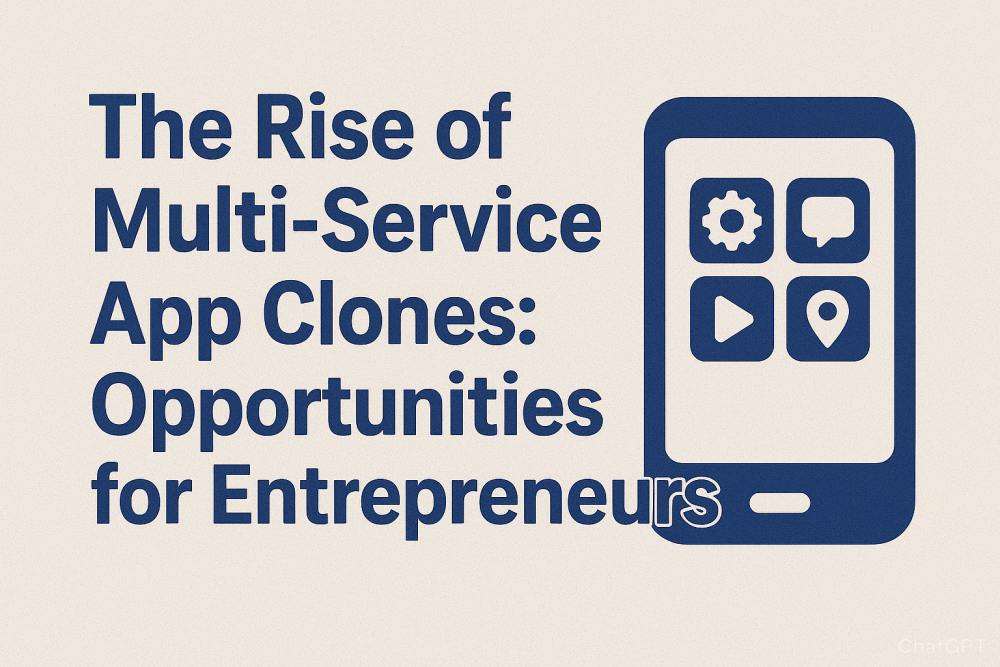In today’s digital transformation landscape, convenience has emerged as the new currency. People don’t just want an app that does one thing anymore but they expect a single platform that can handle multiple parts of their daily life. This is where the clones of multi-service apps, frequently referred to as “super app clones,” are gaining prominence. These platforms combine food delivery, ride-hailing, grocery shopping, bill payments, and sometimes even home cleaning, all under one roof. For entrepreneurs, this trend is not just another passing phase but it’s an opportunity to enter a booming market where customer expectations are changing rapidly.
Why Multi-Service Apps Are Booming
Think about your phone for a moment. How many apps do you actually use every day? The truth is, people are tired of juggling a dozen different apps just to get through simple tasks. Multi-service apps solve this frustration by bringing it all together. Rather than toggling between different apps to order food and to request a cab, the users can accomplish everything in a single location.
The success of platforms like Gojek and Grab proves how powerful this model can be. Once users become accustomed to handling everything from groceries to payments within one app, it becomes extremely challenging for rivals to lure them away. It’s not only about conserving device space but it’s also about fostering loyalty via consistent interaction.
Cost Efficiency for Everyone
Apps providing various services are not just convenient for users but are also cost-effective for businesses. Customers gain advantages from package deals, loyalty incentives and the convenience of paying for several services together. For the entrepreneurs, this means reduced marketing costs because the app establishes an environment in which customers effortlessly move between different services.
Picture this situation: a person places a dinner order, and while they wait, the app offers a discounted ride back home. It’s not merely upselling but it’s an intelligent method to maintain user engagement without being intrusive. When services enhance each other in this manner, both clients and companies benefit.
The Secret to Getting It Right
Creating a multi-service app isn’t simply about adding numerous features; it’s about integrating them so they seem inherent. The user interface should be straightforward and user-friendly, as no one desires to spend time deciphering complex menus. Payments have to be smooth and secure, because one bad experience is enough to drive someone away forever. And personalization matters more than most people think. If a customer books cabs every weekday morning, why not show them a quick coffee deal on the way? Such small details make the experience lively and personable.
Updates in real-time are another crucial component. Individuals seek to find out the location of their food, the arrival time of their taxi, or if their payment has been processed. That feeling of openness fosters trust and trust is the basis of loyalty.
Opportunities for Entrepreneurs
While giants dominate certain regions, the market is far from saturated. Entrepreneurs continue to have ample opportunities to achieve success, particularly by concentrating on local markets and customizing services for particular communities. In many places, global players haven’t yet built strong networks, leaving a gap for agile newcomers.
An alternative perspective is specialized multi-service applications. Rather than attempting to serve all markets, some entrepreneurs are developing platforms focused on specific sectors such as healthcare, education, or home services. These smaller ecosystems maintain the essence of convenience while concentrating on a specific audience. The good news is that app clones allow for quicker launches, giving startups the ability to test and adapt without spending years on development.
Challenges Along the Way
Certainly, creating an app like this isn’t an easy task. Managing operations across multiple verticals requires solid partnerships, strong backend systems, and yes, serious investment. Data security is also a major concern. One slip in handling user data or payments can ruin trust in seconds, and trust is painfully slow to rebuild.
But challenges also create barriers to entry. If you can solve these problems, you’re already ahead of the curve. It’s not easy, but that’s exactly why the rewards can be so significant.
Why App Clones Make Sense
The term “clone” can sound unoriginal, but in practice, it’s about working smarter. Instead of reinventing the wheel, entrepreneurs can start with a proven model and customize it for their audience. This reduces costs and dramatically shortens the time to market. You don’t need to be the next Gojek or Grab, you need to be the first super app that understands your local community better than anyone else.
Looking Toward the Future
The next generation of multi-service apps will go far beyond today’s features. With AI and machine learning, apps will be able to anticipate user needs before they’re even expressed. Your application may recommend requesting a taxi when it detects a meeting on your schedule or alert you to purchase groceries when it realizes you’ve depleted basic necessities. Add in Internet of Things (IoT) integration, and the possibilities expand even further.
For business owners, now is the time to take action. The technology is prepared, the demand is significant, and the opportunity for newcomers to make their mark is vast.
Conclusion
The emergence of multi-service app replicas indicates the transformation of digital existence. People no longer want fragmented solutions, they want everything in one place, delivered quickly and reliably. For entrepreneurs, these applications create opportunities to establish ecosystems instead of merely products.
Ultimately, users are indifferent to whether your app originated as a copy. What matters is whether it makes life simpler, saves time, and offers real value. Get that right, and your app won’t just ride the multi-service wave but it will shape the way people live and interact with technology.
